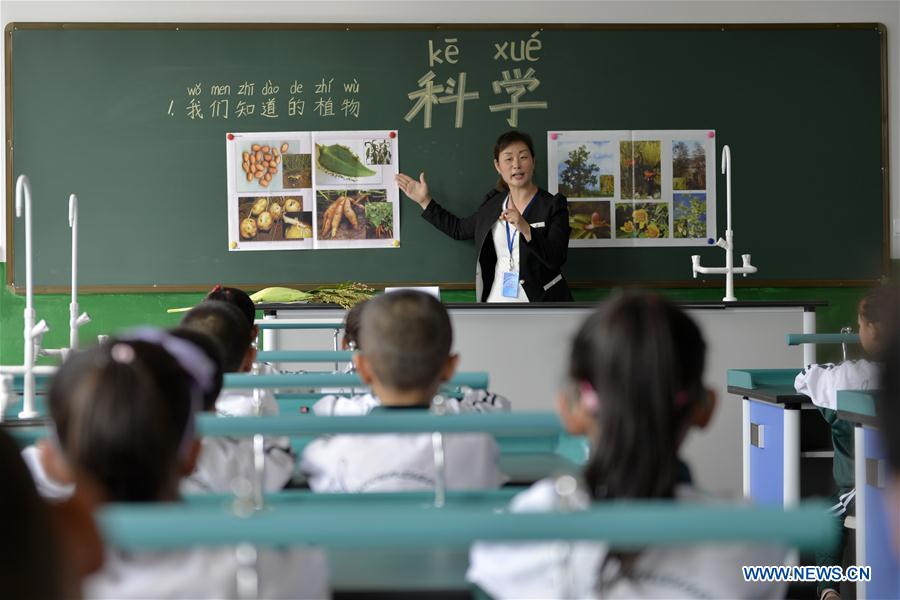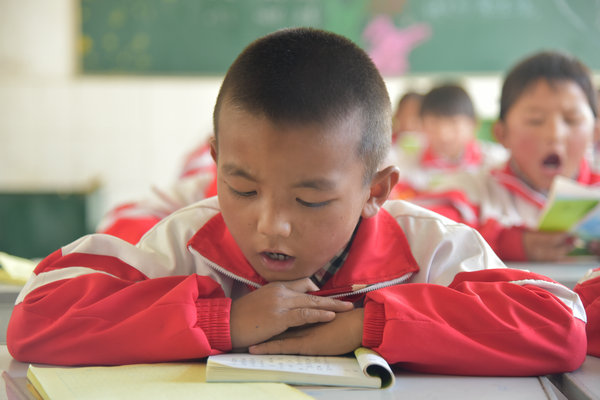Education investment increased in China's Tibet and Tibetan-inhabited areas
In recent years the Chinese government has continued to increase investment in education in Tibet and Tibetan-inhabited areas in Qinghai, Gansu, Sichuan and Yunnan provinces, resulting in rapid development of education in these areas.
In 2015 Chinese President Xi Jinping stressed at the sixth conference on Tibet work that changing the appearance of Tibet and Tibetan-inhabited areas fundamentally depends on education.
In April 2016 group education aid was officially launched. The first group of 800 teachers from 17 provinces and municipalities including Beijing, Shanghai, Hunan and others provided assistance at 20 primary and secondary schools in southwest China's Tibet. This new model has changed the previous system of short-term aid as the cycle is three years with the aim of helping Tibet build a group of high-level primary and secondary schools.
As the first place to try group education aid in Tibet, education aid work achieved remarkable results in Lhasa, capital city of Tibet. Three schools in Lhasa received assistance, with 195 teachers and 21 staff from inland China being sent here to take part in the group aid, and a total of 483 million yuan (73 million US dollars) was invested.
Tibet has already implemented 15 years of free education from kindergarten up to high school. School conditions in the region have improved significantly, teaching staff continue to strengthen and there has been a substantial increase in the quality of teaching.
Apart from the Tibet Autonomous Region, northwest China's Qinghai Province has the largest Tibetan-inhabited area in China. Of the ten Tibetan autonomous prefectures in China, six are in Qinghai. The population of Tibetan-inhabited areas in the province is 2.1 million, accounting for 36% of the total population of the province.
Since the 18th National Congress of the Communist Party of China in 2012, Qinghai has accelerated reform and development of ethnic education. Funding for education in Qinghai increased from 15.532 billion yuan (2.358 billion US dollars) in 2011 to 21.679 billion yuan (3.291 billion US dollars) in 2016, an increase of 39.6%.
Since the "Twelfth Five-Year Plan" (2011-2015), 25.76 billion yuan (3.91 billion US dollars) of funds have been invested in education projects. 1,499 kindergartens including bilingual kindergartens and kindergartens in farmland and pasturing areas have been built; 1,189 schools have been newly-built or renovated; and student nutrition improvement plans have been implemented in poverty-stricken counties.
Starting from 2016, 15 years of free education has been introduced for all students in the six prefectures, with an investment of 1.79 billion yuan (0.27 billion US dollars), benefiting more than 800,000 students from various ethnic groups.
Southwest China's Sichuan Province has vigorously promoted the Ten Year Action Plan for Education Development in Ethnic Areas in recent years. During the "Twelfth Five-Year Plan" (2011-2015), Tibetan Secondary Schools including the Tibetan Middle School of Aba County in pasturing areas in Aba prefecture received a total investment of 213 million yuan (32 million US dollars) for infrastructure construction.
In the space of a few years the Tibetan Middle School of Aba County had school hardware facilities to match that of schools in inland China. A school teacher said that the school now covers an area of 119 mu (7.9 hectares), which is seven times larger than before. It is now complete with everything including a teaching building, laboratories, art building, student canteen and other facilities.
Dechen Tibetan Autonomous Prefecture is the only Tibetan autonomous prefecture in southwest China's Yunnan Province. Since 2014 Yunnan has increased investment into schools with poor compulsory education in ethnic areas. In 2016, Dechen and Nujiang prefecture took the lead by implementing 14 years of free education from kindergarten to high school, as well as providing living subsidies.
Up until the end of 2016 the school buildings of schools in Dechen at all levels covered an area of 1,160,418.42 square meters, with each primary school student occupying an average area of 17.07 square meters and each secondary school student 24.2 square meters.
During the "Twelfth Five-Year Plan" (2011-2015), Gannan Tibetan Autonomous Prefecture in northwest China's Gansu Province, invested 523 million yuan (79 million US dollars) in building and renovating 327 kindergartens, leading to an increased intake of 11,739 children. Admission rates for year 1, 2 and 3 of pre-school education have increased 73.08%, 47.87% and 39.8% respectively compared to 2010.
Enrollment rates for primary school and junior high school age children have increased from 98.68% and 97.45% in 2010 to 100% and 98.8% today. High school enrollment rates have increased from 67.61% in 2010 to 79.02 and the number of students taking the college entrance examination has increased from 3,852 in 2010 to 6,619 today.
Bilingual teachers in the prefecture have increased from 263 when it established to 12,100, with 128,000 students enjoying bilingual teaching.
Thus a modern education system from pre-school up to higher education has formed.
Your Comment
Name E-mailRelated News
-
;
-
-

-
China increases science education to boost innovation
In February this year, China's Ministry of Education issued a new guideline for science education, requiring elementary schools to make science a compulsory subject for first-grade students.
-
-
-

-
Tibet implements 15 years of free education
Southwest China’s Tibet offers 15 years of free education from kindergarten to high school, including for students who attend vocational schools after graduating from middle or high school.
-
-
-

-
Teachers sent to aid Tibet boost local education
For the past 35 years, teacher Jiang Yiming has been dreaming about being part of an education aid program.
-
Based in Lhasa, Tibet Vista is a Tibet travel agency that specialized in Tibet permit, and Tibet tours for both private and group travelers at a local price!
•4 Days Lhasa City Group Tour from USD 460 •8 Days Everest Base Camp Group Tour from USD 850 •15 Days Mt.Kailash Group Tour from USD 1780 •2016 Tibet Train Tours from Beijing, Shanghai, Chengdu, Xining,etc










